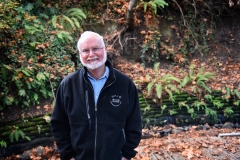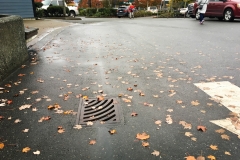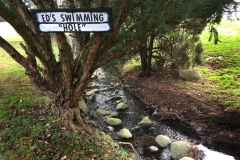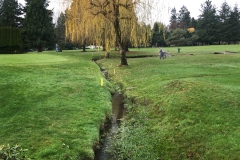
Ken McDonald in front of Golf Creek and the first bank that collapsed and his $15,000 geotextile wall. Photo by George Le Masurier
Golf Creek: A case study in stormwater planning gone wrong
This is the second in a series of articles about how traditional stormwater management has contributed to the death of waters in our urban environment, and how we’re learning from those mistakes.
Today’s story begins the Tale of Three Creeks: Golf, Brooklyn and Morrison. Golf Creek is dead, Brooklyn Creek is threatened and Morrison Creek is thriving, with a pristine and intact headwaters that the Comox Valley Land Trust and the Morrison Stream Keepers hope to protect.
Like most Albertans, Ken and Norine McDonald moved to the Comox Valley for its moderate climate and natural beauty. From the front window of the house they would purchase on Jane Place in Comox, the Beaufort Range of mountains formed a forested backdrop for the K’omoks Estuary as it flowed into the Salish Sea.
Behind the house, the picturesque Golf Creek meandered around a bend on its way to Comox Bay. There were stairs down to a wooden bridge over the creek, where their granddaughter often splashed and played in the water.
They didn’t know then that fecal coliform in the creek could reach 230 times the maximum allowed under BC Ministry of Environment water quality standards, or that mercury levels could exceed limits by 800 times. Or that the water sometimes contained 50 times the provincial maximum of copper, which can be deadly to salmon.
And they did not know initially that the large volume of fast moving water that was undercutting their stream bank came from a confluence of pipes carrying contaminated stormwater runoff from most of downtown Comox.
It’s hard to find Golf Creek today, unless you play golf. The creek runs between the third and fourth holes of the Comox Golf Club, crosses the fourth and fifth fairways, and then disappears into a pipe under the Comox Mall and the Berwick Retirement Community. It surfaces again on private property from the south side of Comox Avenue down to Comox Harbour.
Twenty-three separate municipal stormwater pipes gush contaminated runoff into Golf Creek. Eighty-six percent of the creek is buried and no fish even attempt to swim it. It is, for all intents and purposes, dead.
The lawsuit
After the McDonald’s spent $15,000 constructing a green geotextile wall to guard against further erosion of their property, they discovered the high volume and fast flow rate of the creek after rainfalls was a result of stormwater runoff from the neighborhoods north of the golf course, the course itself and most of downtown Comox. Months later, another section of the McDonalds’ bank collapsed, which will cost another $15,000 to repair.
When the town refused to accept responsibility for the damage and compensate them, the McDonalds filed a small claims court lawsuit in June of 2016. They have spent $20,000 on a nearly three-year legal battle that has not been settled.
“The town’s strategy is simple, bleed our savings until we relent,” McDonald said.
During research for their legal case, the McDonalds discovered the town had commissioned multiple engineering reports that recommended mitigation measures for the high volume and flow rate of Golf Greek. Several of them, including a 26-year-old report by KPA Engineering, advised the town to construct a detention pond to control the release of upstream rainwater and to help settle out contaminates.
The town continues to ignore those recommendations.
Golf Creek: what happened
For 2,000 years, indigenous peoples continuously occupied the stretch of Comox Harbour in the lee of Goose Spit, living off of a wide range of natural food sources. They harvested fish from Golf Creek and Brooklyn Creek, drank their waters and harvested shellfish during the summer low tide cycles.
Colonial occupation and eventual urban development took a toll on both creeks, but Golf Creek suffered the most. While lumber baron Robert Filberg preserved a large chunk of green space for a golf course, through which the creek still flows today, residential development above the golf course buried the creek’s headwaters, and a shopping mall buried a short portion below the course.
But the creek was still alive.
In the 1960s and 1970s, long-time Comox Residents Greg Rohne and Ted Edwards remember seeing fish in the creek, and watching tiny newly-hatched salmon fry. Another long-time resident, Gordon Olsen remembers catching fish in the creek as a teenager.
The creek was still natural below the Comox Mall when the BC Legislature passed the Riparian Areas Regulation (RAR) in July of 2004. It added stricter protections for provincial waters than the previous Streamside Protection Regulations of 1997, which compelled local governments to “protect streamside protection and enhancement areas” from residential, commercial and industrial development.
That should have prevented the town from allowing more of Golf Creek to be buried in pipes, but it did not. The RAR’s accompanying regulations weren’t issued until March 31, 2005.
A few months after the RAR was enacted, Berwick was granted a development permit that included permission to build over Golf Creek. And a building permit was issued on Jan. 4, 2005, just weeks before the enforcing regulations came into effect.
Beyond erosion, health concerns
Leigh Holmes, a retired professional engineer, has lived near the mouth of Golf Creek, about 200 metres downstream from the McDonalds, since 1998. In an affidavit sworn for the McDonalds’ lawsuit, Holmes says the creek has been turned into a sewer.
When a thick white foam coated the surface of the creek in 2002, Holmes “discovered that the Fire Hall was testing foam fire retardant during training and that they had hosed the excess foam into a nearby road gutter.”
Three weeks ago, CFB Comox announced it would conduct precautionary groundwater testing after a toxic substance found in firefighting foams, known as PFAS, was detected in nearby groundwater and Scales Creek.
In his affidavit, Holmes said “the creek is virtually devoid of life and is heavily polluted. The Town of Comox has transformed what once gave sustenance to people for hundreds of years into an open sewer.”
McDonald had concerns about water quality in the creek, because his granddaughter frequently played in it. He took a water sample on Sept. 7 and had it analyzed by Maxxam Analytics in Burnaby and the results interpreted by Victoria biochemist C.A. Sigmund.
Sigmund found high concentrations of nine metal ions, including mercury and copper, and he found an extremely high fecal coliform count, possibly through cross-contamination from town sewer pipes, and most probably from pets, birds and deer, which are abundant in Comox.
The expert noted that the data represented a snapshot in time. He recommended that water quality should be monitored regularly for 12 months, and that point sources of contamination should be identified.
This has not been done, in spite of the fact that the town was repeatedly advised to do water quality testing as far back as a 1999 Koers and Associates Stormwater Drainage Study commissioned by the town.
Even now, the town has not monitored Golf Creek water quality.
Recommendations ignored
The McDonalds commissioned a study by Dr. Richard Horner, an international expert on stormwater located in Seattle, Washington, to analyze the town’s stormwater discharges into Golf Creek and their role in the erosion of McDonalds’ property. Horner assessed nine separate engineering consultant studies between 1992 and 2014 in his analysis.
Horner found the town “ignored recommendations from its consultants, and even its own Official Community Plan that could have prevented or at least arrested the erosion of Golf Creek and the delivery of urban pollutants to Comox Harbour.”
Horner pointed to three reports that specifically recommended an upstream detention pond or other water control measures. He noted three others that recommended water quality monitoring programs.
The town did take some action to divert stormwater from Golf Creek, but Horner found “the actions the Town of Comox did take have been relatively ineffective in addressing the channel erosion and water quality problems created by permitting development without stormwater runoff mitigation.”
Lessons from Golf Creek
The McDonalds say they care about the environment of their community. They have begun a project to construct a net-zero-energy addition to their home, which will create roughly the same amount of energy or more than it consumes. Their home will also manage most of its stormwater via a green roof, a 3,000 gallon rainwater harvesting system and a pervious paver driveway.
McDonald sees himself as a warrior for change.
“There are three ways to get local governments to improve their stormwater practices … using education, a carrot, or a stick. Some municipalities respond to education, some won’t move until the province hands over bags of money, and sadly, others only change when compelled to do so by a judge.
“Our hope is that the new mayor and council will respond to education.”
The tale of Golf Creek may represent a bad case of urban planning gone wrong, but it is not an isolated case. Over the last several decades, many Comox Valley creeks and streams have disappeared from view and are now in pipes under parking lots, buildings and roadways.
And it’s not an unwarranted fear that without a change in development practices by municipal planning and engineering staffs, and given the region’s rapid rate of population growth, every creek or stream in the Comox Valley could be polluted to death. Many more could disappear entirely despite the tireless work of hundreds of volunteer stream keepers.
Golf Creek may never have fish again. But McDonald hopes to force better stormwater practices by the town that could still help protect Brooklyn Creek and Cathrew Creek, and other Comox Valley waters from dying the same death.
The Town of Comox did not respond to a request for comment on this story. But a lawyer for the Municipal Insurance Association of British Columbia did respond saying “our office has no comment until this court matter ceases.”
For further reading …
RIPARIAN AREAS REGULATION — Riparian areas link water to land. They border streams, lakes, and wetlands. The blend of streambed, water, trees, shrubs and grasses in a riparian area provides fish habitat, and directly influences it. Read more here
STREAMSIDE PROTECTION REGULATION — A fish protection act preceding the Riparian Areas Regulation. Read more here
GEOTEXTILE — Fabrics that, when used with soil, have the ability to separate, filter, reinforce, protect and drain. Read more here
FECAL COLIFORM — Microscopic organisms that live in the intestines of warm-blooded animals. They also live in the waste material, or feces, excreted from the intestinal tract. Although not necessarily agents of disease, fecal coliform bacteria may indicate the presence of disease-carrying organisms, which live in the same environment as the fecal coliform bacteria. Swimming in waters with high levels of fecal coliform bacteria increases the chance of developing illness (fever, nausea or stomach cramps) from pathogens entering the body through the mouth, nose, ears, or cuts in the skin. Diseases and illnesses that can be contracted in water with high fecal coliform counts include typhoid fever, hepatitis, gastroenteritis, dysentery and ear infections. Read more here and here
RUNOFF — Excessive rain or snowmelt that produces overland flow to creeks and ditches. Runoff is visible flow of water in rivers, creeks and lakes as the water stored in the basin drains out.
DR. RICHARD HORNER — To read some scholarly articles by this international expert on stormwater, click here
PFAS — A group of man-made chemicals that includes PFOA, PFOS, GenX, and many other chemicals. PFAS have been manufactured and used in a variety of industries around the globe, including in the United States since the 1940s. PFOA and PFOS have been the most extensively produced and studied of these chemicals. Both chemicals are very persistent in the environment and in the human body – meaning they don’t break down and they can accumulate over time. There is evidence that exposure to PFAS can lead to adverse human health effects. Read more here, and here







Our watershed including the fish and their habitat are facing serious threats from Rock Snot, biofilms, Whirling Disease, and warming temperatures.
Re: your comment “Golf Creek may never have fish again”, I would hope that is incorrect and where there is a will there can be a way. People do need to: become vigilant; report offenders; prevent contamination of storm sewers and enforce vehicle maintenance and compliance from 100% of businesses, homes and vehicle operators as pertains to preventing toxins (as far as is possible) from entering the environment.
The consultants recommendations re: a monitoring program and detention ponds should be implemented ASAP. There should be no choice of opting out of such basic, sensible, solutions. Perhaps there is government (read ‘our’) money available from either Provincial or Federal reserves to help with the costs that Comox has so far been unwilling or unable to meet? That creek is not a static thing to just label ‘toxic’ and give up on. New water flows through it continually bringing new chances for better water quality testing results every moment. The sources polluting it are actual and as such able to be found and fixed.
Here is an example of how to relate to this sort of thing and these measures are happening just over the water in the biggest city around here:
https://vancouver.ca/home-property-development/restoring-streams.aspx
It doesn’t take long before a Council and it’s senior administrators feel entitled. Comox’s past council and its senior administrators have embraced entitlement for the last decade. Of our four Valley governments Comox has shunned community advice and support on the environment. Maybe new, fresher and younger politicians will not fear community involvement, however it will have to contract new senior administrators before it will see any change.
When that is done, and they have a new receptive attitude to community support and environmental involvement; then and only then will we see positive change. Such as opening covered creeks to the sky. Three creeks come to mind Beaufort, Brooklyn and Golf Course creeks.
Jim Gillis
Once again George has knocked it out of the park, bringing clarity and depth to complex issues.
Are fecal coliform counts taken in Comox Bay? Don’t people swim off the beaches? Are the beaches themselves, the sand, grasses, logs tested for heavy metals?
I don’t think anyone is testing water quality in Comox Harbour. My guess is that Island Health says it’s a Ministry of Environment issue, and the MOE will say it’s a DFO issue, and DFO will say, fecal coliforms don’t really affect fish, so … who you gonna call?
Of course the new council will have to deal with the negligence of the old council. We can expect to hear an outcry from the citizens who always complain about taxes too. They’re to cheap to protect little children from contaminated water! Meanwhile the former Council members will never be held to account for their inaction. What were they doing while in office? They certainly weren’t looking after their constituents or their environment. Too busy with real estate development, I guess. How irresponsible for local politicians to ignore something as important as the health of our community. How can they justify such ignorance? IMO they should be in jail.
The Town of Comox has boasted about being “debt free.” But did they achieve that at the expense of ignoring stormwater infrastructure projects recommended by their own consultants?